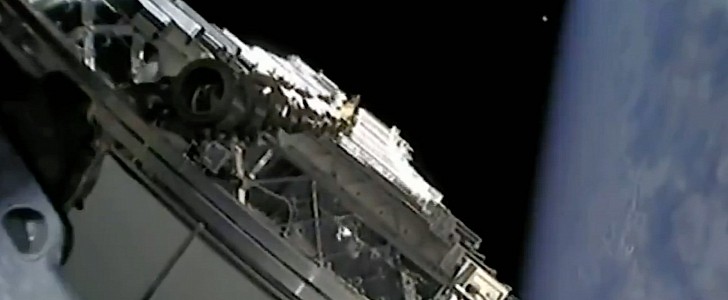At the time of this writing, SpaceX just deployed an additional 60 Starlink satellites. They will join the others up there in orbit in the hopes of making Elon Musk the god of satellite internet access, as the science community is growing angrier with all the junk we keep sending up there.
For a while now, scientists who look at the sky for a living have been crying that the glow caused by orbiting satellites and other types of space junk interferes with Earth-based instruments used to search the depths of space.
If there was any need for proof to support that claim, just remember how in the summer of last year, a Canary Islands-based photographer came up with a very peculiar shot of the Neowise comet on account of the Starlink satellites.
And now comes a scientific paper to back the claim that satellites can have a real impact on astronomy efforts. Published back in March by M. Kocifaj from the Slovak Academy of Sciences, it is among the first to determine just how severe this impact is.
According to the researchers, night sky brightness levels are changed by the sunlight reflected by orbiting bodies. Since there’s a lot of them out there, light gets scattered and comes in conflict with those looking up from Earth—as you probably know, it takes pitch darkness to see the stars properly.
As measured by Kocifaj, zenith luminance (that would be the luminance of the sky directly overhead) over the past few years jumped to 10 percent over the night sky's brightness determined by natural sources of light. That might not seem like much, but it breaks the light pollution level established in 1979 by the International Astronomical Union and causes radio interference and information loss for instruments studying the stars.
The paper concludes that the “proliferation of space objects is a rapidly increasing source of artificial night sky brightness” and affects “both space operations and ground-based optical and radio astronomy.”
Is there a way out of this? Of course not. We’ll probably not stop sending stuff into orbit in the foreseeable future (if anything, the pace of this activity will likely accelerate), and we certainly won’t begin clearing the skies of all the junk now orbiting aimlessly around our world.
SpaceX, for instance, will continue putting its internet satellites in orbit until 12,000 of them are out there, surrounding our world.
If there was any need for proof to support that claim, just remember how in the summer of last year, a Canary Islands-based photographer came up with a very peculiar shot of the Neowise comet on account of the Starlink satellites.
And now comes a scientific paper to back the claim that satellites can have a real impact on astronomy efforts. Published back in March by M. Kocifaj from the Slovak Academy of Sciences, it is among the first to determine just how severe this impact is.
According to the researchers, night sky brightness levels are changed by the sunlight reflected by orbiting bodies. Since there’s a lot of them out there, light gets scattered and comes in conflict with those looking up from Earth—as you probably know, it takes pitch darkness to see the stars properly.
As measured by Kocifaj, zenith luminance (that would be the luminance of the sky directly overhead) over the past few years jumped to 10 percent over the night sky's brightness determined by natural sources of light. That might not seem like much, but it breaks the light pollution level established in 1979 by the International Astronomical Union and causes radio interference and information loss for instruments studying the stars.
The paper concludes that the “proliferation of space objects is a rapidly increasing source of artificial night sky brightness” and affects “both space operations and ground-based optical and radio astronomy.”
Is there a way out of this? Of course not. We’ll probably not stop sending stuff into orbit in the foreseeable future (if anything, the pace of this activity will likely accelerate), and we certainly won’t begin clearing the skies of all the junk now orbiting aimlessly around our world.
SpaceX, for instance, will continue putting its internet satellites in orbit until 12,000 of them are out there, surrounding our world.
Deployment of 60 Starlink satellites confirmed pic.twitter.com/xiqbY1Bviw
— SpaceX (@SpaceX) April 29, 2021

